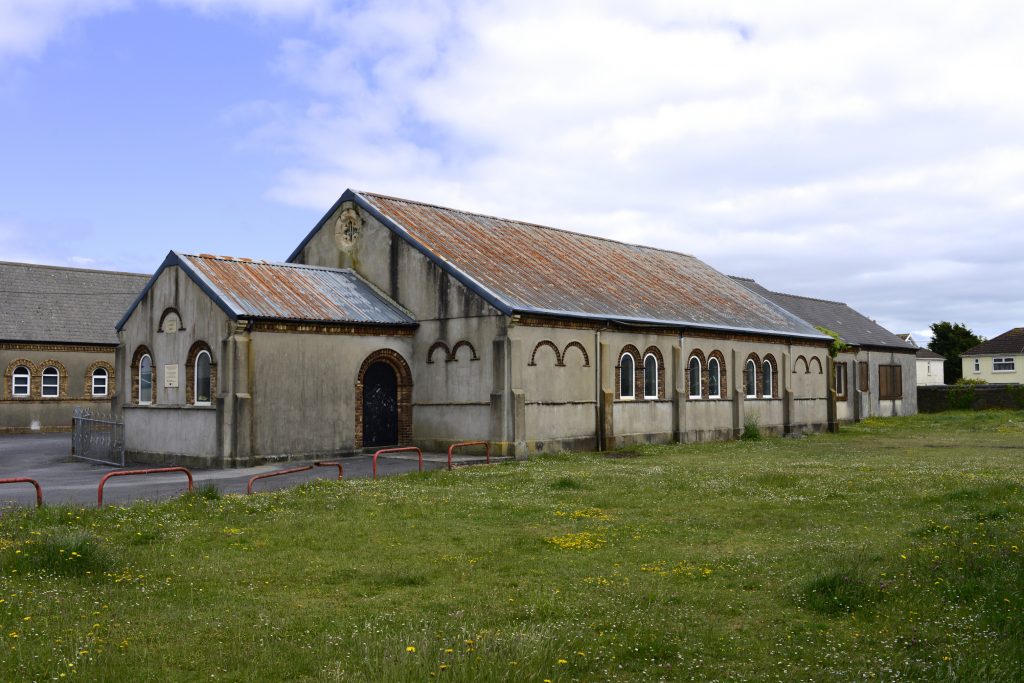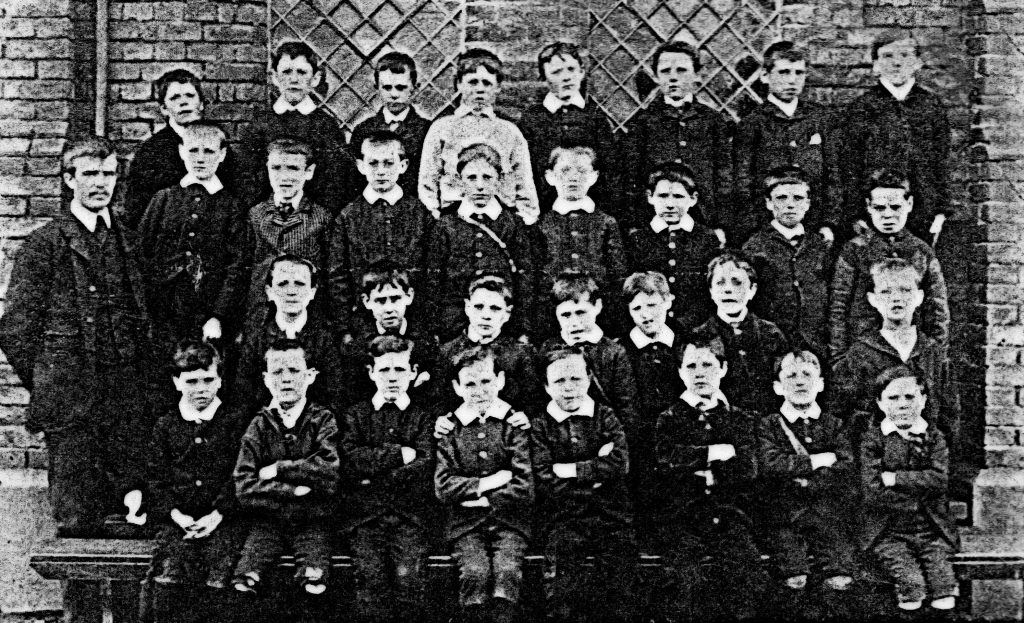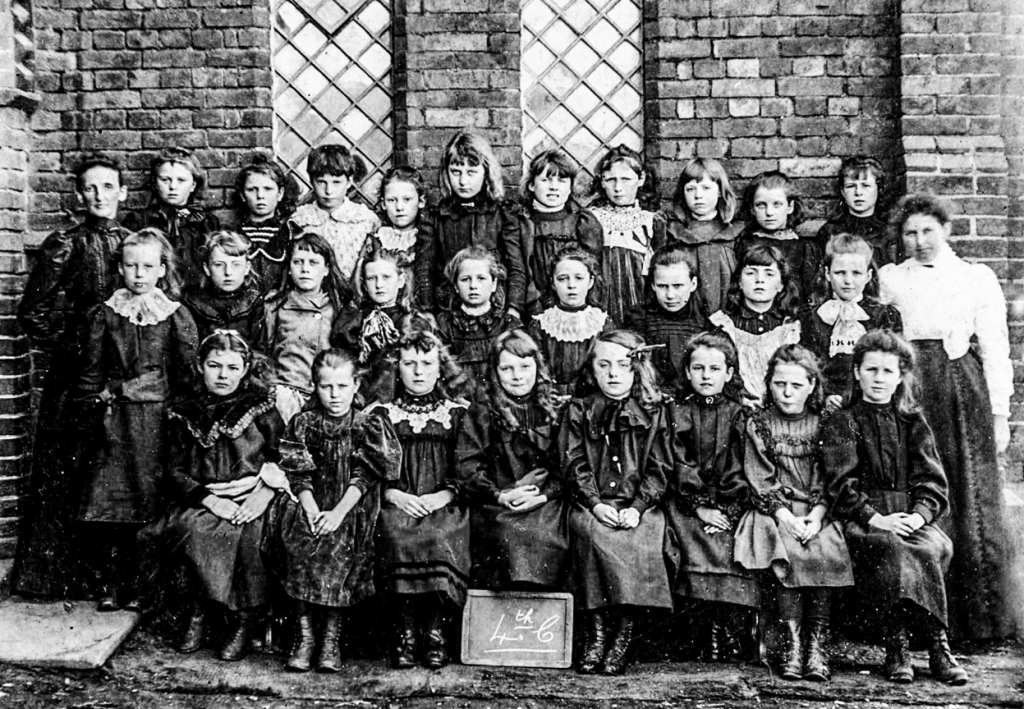
PEMBREY COPPER WORKS SCHOOL – THE EARLY DAYS.
The copper works at Pembrey was a later development in copper smelting when compared to the works further east. It was built in 1849 by Messrs. Mason and Elkington, who came from Birmingham and London. The Copperworks School was opened in August 1855 as three schools – girls, infants and boys. Built for the workers employed by Mason and Elkington in their copper works, collieries, and brickworks, the buildings cost £1,700 of which the entire sum was contributed by the Company, who also gave £270 for its upkeep.
The annual income of the school was derived from a deduction of 1 1/2d per week from the wages of the men employed by the copper works company which amounted to about £90 on average each year. Children whose parents were not employed by the company paid 2d each week. Any deficiency was made up by the owners of the company.
Works schools needed to affiliate to one of the two voluntary societies in order to obtain a government grant. Pembrey was linked to the British and Foreign Schools Society which mainly reflected the nonconformity in Wales. The other society was the National Society linked to the Anglican church. However, the proprietors agreed to the establishment of a non-denominational or non-sectarian school in which the Bible was the sole basis for religious instruction, no church catechism was used and children of any religious background or creed were admitted.
Another important feature was that no preference was given to children who had been educated in the copper works school when vacancies arose at the works. The main criteria were ability and skill. Ten years following the opening the majority of pupils at the school were ‘outside’ children, whose parents were not employed at the works.
In 1858 the head teachers of the girls and infants and of the boys’ school completed questionnaire for the British and Foreign School Society. Copies were obtained from their archives and they provide the following information for the first two years of the schools. The boys school Head was Richard Williams and the girls and infants school Head was Sarah Furness.
BOYS SCHOOL

The questionnaire was signed by headteacher Richard Williams and dated December 17, 1858. Information is given for the years 1856 and 1857.
The official name of the school was Pembrey Copper Works School and was calculated to accommodate 150 children. The head teacher describes the area as a mix of agricultural, mining and manufacturing. The total number of scholars belonging to the school was about 120. There was no evening school provided.
The staffing comprised one paid master, two pupil teachers and one monitor.
On the day that the return was made the following numbers of boys were in attendance: above six years of age and not more than nine – 29 boys; above nine and not more than twelve – 27 boys; above twelve years and not more than thirteen – 16 boys; above 13 years and not more than fifteen – 4 boys; above fifteen years and not more than twenty -3 boys.
The average age at which the boys were admitted into the school was about nine years of age and the average age at which they left the school was 11 years and decreasing.
The average number of days per year during which the children are found to attend school’s is 146. In 1856 the total number of scholars belonging to the school was 118 and in 1857 it was 103. The total number of scholars who attended school during 176 whole days was in 1856, 39 and in 1857, 19.
The subjects taught in the school were religious knowledge, history, grammar, geography, reading, writing, arithmetic, vocal music and mapping.
GIRLS SCHOOL

The return was signed by the headmistress Sarah Furness on December 17, 1858
The school catered for infant boys and girls of all ages. At the time of the questionnaire there were 34 boys and 148 girls belonging to the school. There was no evening school.
Staffing comprised one paid mistress and one assistant mistress, two pupil teachers and three monitors.
On the day on which the return was made the following numbers of girls were in attendance: under three years of age – 6 boys and 4 girls; from three to six years of age – 11 boys, 14 girls; above six years of age and not more than nine – 29 girls; above nine years of age and not more than twelve – 32 girls; above twelve years of age and not more than 13 – 9 girls; above thirteen years of age and not more than fifteen – 10 girls; above fifteen years of age and not more than twenty – 3 girls.
The average age at which girls leave the school was 13 and decreasing.
The average number of days per year during which children were found to attend the school was about 139.
In 1856 the total number of scholars belonging to the school was 13 boys, and 134 girls. In 1857 the number was 21 boys and 152 girls. In 1857 the total number of scholars who attended the school during 176 whole days was 2 boys and 47 girls.
The subjects taught at the school were Scripture, reading, writing, arithmetic, grammar, geography, sewing, cutting out, knitting, domestic economy.
To induce parents to send their children to school rewards were given to each child who had attended 176 days. The nature of the reward is not described.
THE OPENING

There are two accounts of the opening of the schools: one in the Welsh journal Y Diwygiwr of September 1855, and the other in the Welshman in August 1855. In the former, local minister Rev Henry Evans describes the building as splendid, beautifully painted with colourful maps hanging on the walls. It seems a large number of the company’s employees and their wives were present. Rev Evans suggests up to 500 people enjoyed tea and cakes provided by the company. Mr Apsley Smith of New Lodge in his speech encouraged the parents to support the headteachers, to show interest in their children’s work and to keep the children clean. He also made clear the distinction between the non-denominational copperworks school and others in the area supported by the National Society.

In the latter longer account, the reporter describes the building as very capacious, consisting of boys and girls schoolrooms, and two class rooms. The dimensions of the long rooms which run parallel to each other were 63 feet by 24 feet and about 14 feet high. “On entering the boys’ school the visitors were struck with the very elegant appearances of the decorations and festoons of flowers and evergreens were dispersed with great profusion and taste. Maps and illustrations from scripture, natural philosophy and the mechanical powers were there in abundance and, as a crowning piece, there was a beautiful device of flowers and evergreens with the initial letters ‘M’ and ‘E’ (Mason and Elkington) which produced an excellent effect during the evening when lighted with brilliant lamps.”
There seemed to be lots of books of every kind for teaching reading, arithmetic, crafts and music and the building also included a public library and reading room. The fact that the building was regarded as large enough to accommodate four or five hundred children is an indication of the normative standards of the day.
The report in the Welshman went on to praise the employees – “During the evening the order and decorum of this large concourse of workmen and their families did not fail to convince every visitor that Messrs. Mason and Elkington were favoured with steady and industrious employees”, and then the ladies, each one named, “who served the tea with untiring zeal”. Also mentioned were the ‘great and the good’ of Pembrey and Burry Port who were in attendance with some well known family names recorded: for example, McKiernon, Wedge, Parkes, Stanley. Interestingly, the names absent in both accounts are those of the headteachers, an indication of the fairly lowly status of teachers at this time.
A number of speeches were made by local ministers and by Mr. A. Smith, the head manager of the works, who was also called to preside. The meeting ended with three cheers be given to Messrs. Mason and Elkington “for the handsome manner in which they had been entertained, which was responded to with enthusiasm”.
SOURCES
- Archives of the British and Foreign Schools Society.
- Leslie Wynn Evans, ‘Education in Industrial Wales’, Avalon Books, 1971.
- ‘Y Diwygiwr’, September 1855.
- ‘The Welshman’, 17th August, 1855.
GRAHAM DAVIES March 2021
